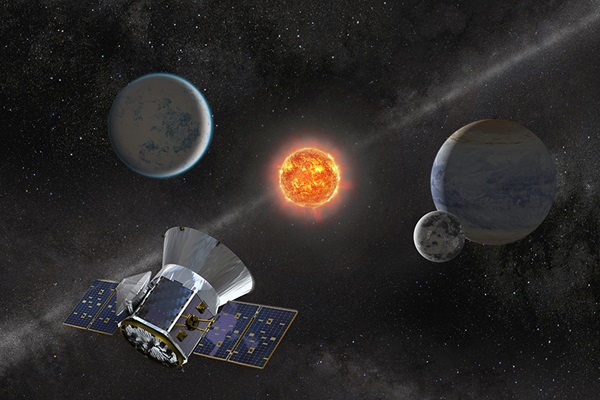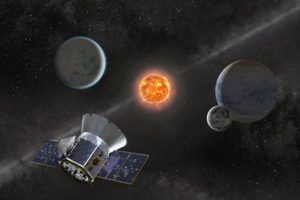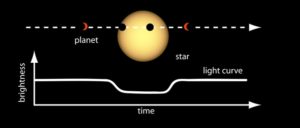TESS شکار جهان های سنگی را شروع کرد

TESS begins the hunt for rocky worlds
TESS شکار جهان های سنگی را شروع کرد
NASA’s newest planet-hunting spacecraft finds 50 candidate worlds during first survey
By Elizabeth Howell | Published: Friday, September 14, 2018

The Transiting Exoplanet Survey Satellite, or TESS, is designed to hunt for planets among nearby bright stars.
ماهواره بررسی سیاره های عبوری یا TESS برای شکار سیاره ها در میان ستاره های نزدیک و روشن.
NASA’s Goddard Space Flight Center
In just six weeks of science observations, NASA’s Transiting Exoplanet Survey Satellite (TESS) has already found 50 possible new worlds for scientists to examine.
مرکز پرواز گودارد ناسا
در تنها 6 هفته از مشاهدات علمی، ماهواره TESS (Transiting Exoplanet Survey Satelite)، 50 عدد از دنیاهای احتمالی را پیدا کرد تا دانشمندان آنرا بررسی کنند.
TESS finds planets by watching the dip in light as a planet passes in front of its parent star. It began science observations on July 25 and the first set of information was available to astronomers on September 5, but the first step in examining TESS’ data is to eliminate false positives. Sometimes a possible “planet” will actually be a binary star blocking its companion’s light, or it could be sunspots on the star’s surface, no second body needed.
TESS سیاره ها را با خیره شدن به کم شدن نور ستاره هنگام سیاره پیدا میکند. این فضاپیما مشاهدات علمی را از 25 جولای شروع کرد و اولین ست اطلاعات در 5 سپتامبر در دسترس ستاره شناسان بود. اما اولین قدم در بررسی داده های TESS این است تا کشفیات مثبت کاذب را حذف کند. بعضی مواقع یک سیاره احتمالی در حقیقت یک ستاره دوتایی است که نورستاره همراهش را بلاک میکند یا این می تواند یک نقطه خورشیدی در سطح ستاره باشد.
While most of these planetary candidates will be discarded upon future analysis, principal investigator George Ricker at the Massachusetts Institute of Technology told Astronomy there are likely six new bona-fide planets lurking in this data alone. Ricker says that usually five to 20 percent of planetary candidates turn out to be true planets, once the transit method is followed up by the radial velocity method on the ground (which observes the influence of an orbiting object). And even amateurs can help with the search, he said.
او گفت وقتی که بیشترین کاندیداهای سیاره در آنالیزهای آینده رد میشود ، محقق اصی جورج ریکر در انستیتو تکنولوژی ماساچوست به استرونومی گفت احتمالا 6 عدد سیاره بونا- فید در داده ها به تنهایی کمین کرده اند. ریکر میگوید در حقیقت 5- 20 درصد کاندیداهای سیاره به سیاره ی واقعی تبدیل میشوند. زمانیکه روش ترانزیت با روش ولوسیتی رادیویی همراه میشود در روی زمین (که اثر یک شی گردان را مشاهده میکند). و حتی آماتورها میتونن به سرچ کمک کنند.
“We make alerts available to astronomers worldwide, and we continue to do that, because there are a lot of amateurs with superb instruments they can use for the initial parts of the screening,” Ricker said, adding the process will likely take months or years due to the number of planetary candidates – suspected rocky planets and larger ones – to double-check.
ما به همه ستاره شناسان در سراسر جهان اطلاع دادیم زیرا خیلی از آماتورها وجود دارند که با ابزارهای عالی ای که در بخش مرحله شروع هستند در سرچ استفاده میشوند. ریکر گفت اضافه کردن پروسه احتمالا چند ماه یا سال را میگیرد تا تعداد سیاره های کاندیدی که مشوک به سیاره سنگی هستند و سیاره های بزرگ تر دو بار چک شوند.+
“As we become more adept at seeking these things out, we are going to get 100 or 200 more [candidates] per sector. There will be a lot to work through. I expect there are going to be 3,000 or so potential objects of interest,” he added.

The transit method of exoplanet detection involves staring at a single star to look for dips in its light associated with the passage of a planet.
NASA
The hunt for nearby planets
It’s a promising start for TESS, which is supposed to find 50 rocky planets — worlds that are four times Earth’s diameter, or smaller — in its primary three-year mission. NASA is on a long-term hunt for planets like Earth, and with the long-running Kepler planet-hunter mission running low on fuel, TESS is billed as a logical successor to Kepler’s work.
این یک شروع نوید بخش برای TESS میباشد که در سه سال اول ماموریت فرض میشود 50 سیاره سنگی را بیابد. جهان هایی که 4 بار در قطر از زمین بزرگترند یا کوچکتر از زمین هستند. ناسا در یک دوره طولانی برای شکار سیاره هایی مانند زمین است و با توجه به ماموریت طولانی شکار کننده سیارات کپلر و اتمام سوخت آن، TESS به عنوان یک جانشین برای کپلر در نظر گرفته شده است.
While Kepler’s primary mission focused on distant stars in a zone of the constellation Cygnus, TESS is an all-sky survey optimized to look at close-up stars. It travels in a never-before-used lunar-resonant orbit that brings TESS around Earth twice for every time that the Moon circles the Earth once. TESS moves its wide view between different sectors of the sky roughly every month.
در حالی ماموریت ابتدایی کپلر بر پایه ستاره های دور در صور فلکی سیگنوس میباشد، TESS به عنوان یک کاوشگر کل نگر به آسمان بهینه شده است تا به ستاره های نزدیک نظر اندازد. TESS در طول یک رزونانس ماهی که قبلا هرگز استفاده نشده است حرکت میکند که روزی 2 بار TESS را در محدوده زمین میآورد در حالی که ماه یک باره به دور زمین چرخیده است.TESS بین 2 بخش متفاوت آسمان تقریبا هر ماه میچرخد.
TESS will study stars that are 30 to 100 times brighter than those surveyed by Kepler. Brighter stars are easier to observe from the ground if something interesting is found, they are also likely closer than most of Kepler’s stars. So the hope is with TESS observations, there will soon be a network of telescopes doing follow-up work on the planets it finds.
TESS ستاره ها را 30-100 بار روشن تر از آنی که به وسیله کپلر انجام شد مطالعه میکند. ستاره های روشن برای مشاهدات از زمین راحت تر هستند زیرا اکر چیز جالبی پیدا بشه آنها احتمالا از ستاره های کپلر خیلی نزدیکتر هستند.
بنابر این امید با تلسکوپ TESS وجود دارد و به زودی یک شبکه از کارهای تلسکوپ که انجام میدهد تشکیل میشود.
All NASA missions go through periodic reviews to determine if they should receive more funding for longer periods of work. So far, indications are positive that TESS will exceed its initial goal of 50 rocky planets; TESS’ observations are already cleaner (better signal to noise) than expected. The spacecraft is also expected to find planets that are larger and gaseous, but its formal goal is more focused on rocky planets.
تمام ماموریت های ناسا به یک بازبینی های دوره ای میرود تا تعیین شود که آیا آنها نیاز به این دارند تا یافته های بیشتر یا کار بیشتری داشته باششند یا نه. تا کنون اشاره ها در مورد TESS مثبت است که هدف اولیه اش را برای پیدا کردن 50 سیاره سنگی تحقق بخشد . TESS از آنچه که قبلا تصور میشد تصاویر بهتری میدهد. فضا پیما همچنین انتظار میرود تا سیاره هایی را پیدا کند که سیارات گازی و بزرگ اند اما خوب هدف رسمی آن پیدا کردن سیارات سنگی است.
Furthermore the spacecraft’s trajectory is so efficient that TESS has enough remaining fuel to do its observations for another century or two; in other words, unlike Kepler, the spacecraft’s end of life will not come from running out of gas. TESS has also effectively tripled its storage capacity because the spacecraft is more stable than expected in its orbit; this means it takes fewer bits per pixel to generate an image and store it on the spacecraft. (Bits per pixel is a measurement of how much information is stored in the image; more bits per pixel requires a larger file size.)
علاوه بر این مسیر حرکت فضاپیما اینقدر موثر است که TESS به اندازه کافی سوخت دارد که مشاهدات را برای یک صده یا دو صده ادامه دهد. به عبارت دیگر پایان زندگی فضاپیما از اتمام سوخت آن فرا نمیرسد! TESS همچنین ظرفیتش سه برابر شده که نشان میدهد فضاپیما بیشتر از آنچه که فکر میشد پایدارتر است به این معنی که این بیت های کمتری را بر پیکسل میگیرد تا تصاویر را درست کند و آن را در فضا پیما ذخیره کند.(بیت بر پیکسل یک اندازه گیری است که چگونه این حجم اطلاعات در تصاویر ذخیره میشود؛ هر چه بیت بر پیکسل بیشتر سایز فایل بیشتر میشود.)
During the extended mission, Ricker said the team will try to send information down to Earth even more quickly to catch more short-term phenomena. TESS has already spied several new near-Earth asteroids, one comet, and a supernova during its short time in orbit, but adding a more rapid response will allow astronomers to see more star explosions — as well as events such as tidal disruptions in stars that are orbiting close to another object, such as another star.
ریکرز گفت در طول این ماموریت گسترده، تیم تلاش میکند تا اطاعات را سریعتر به زمین مخابره کند تا تا پدیده های کوتاه مدت بیشتری را شکار کند. TESS قبلا استروئیدهای نزدیک به زمین ، یک شهاب و یک سوپرنوا در طول دوره کوتاهی که در مدار بود را یافت. اما پاسخ های بیشتر به ستاره شناسان اجازه میدهد تا انفجارهای ستاره ای بیشتری را بررسی کنند. و همچنین حوادثی مانند اختلال های تایدالی در ستاره ها که در نزدیکی اجسام دیگر میچرخند مثل ستاره های دیگر.
What the future holds
اینده ی هولدز چیست؟
While the search for “Earth 2.0” is still ongoing, Ricker said it’s possible there already are small planets sitting in the TESS dataset. “We’ve seen indications that there are several small planets that are in this initial set, and we’re just going through the process of looking at them and making sure that we really got the properties set and it isn’t a false positive,” he said.
ریکرز میگوید در حالی جستجوی زمین 2 در حال پیگیریست که این احتمال و جود دارد که قبلا ممکن است که سیارات کوچکی در ست داده های TESS وجود داشته باشد. ما نشانه های زیادی که سیارات کوچک زیادی در این ست های شروع وجود دارد داریم و در بین پروسه های مشاهده ی آنها هستیم و و مطمئن می شویم که نسبت ها را گرفتم و آن مثبت کاذب نیست.
The candidates TESS finds will also serve as prime targets for follow up with the James Webb Space Telescope (JWST), currently set to launch in 2021. These worlds, if they possess Earth-like life, would have chemical signatures in their atmosphere visible in the infrared — exactly the wavelength regime in which JWST will operate. TESS’ sectors are also perfectly poised in JWST’s “continuous viewing zone,” which is the area of sky it will be able to observe at any time of the year during its orbit.
یافته ها کاندید شده ی TESS همچنین به عنوان هدف اولیه برای پیگیری تلسکوپ فضایی جیمز وب (JWST) است که در ادامه در سال 2021 پرتاب میشود خواهند بود. این جهان ها اگر آنها صاحب زندگی مانند زمین باشند قرار است که نشانه های شیمیایی را در اتمسفرشان داشته باشند که در طیف اینفرارد مرئی است. دقیقا دوره طول موج که در آن JWST عمل میکند. سکتورهای TESS همچنین به طور کامل در منطقه مشاهده مداوم JWST قرار میگیرد که منطقه ای در آسمان است که ما قادریم در هر زمان سال آنها را مشاهده کنیم.
As TESS observations continue, the planets will come pouring in. And as telescopes on the ground and in space follow up, our galactic neighborhood will grow.
در حالی کهTESS مشاهداتش ادامه میابد، سیارات ورود خواهند کرد و همانطور که تلسکوپ های روی زمین و فضا پیگیری میشوند همسایگان کهکشانی ما گسترده تر خواهند شد.
http://astronomy.com/news/2018/09/tess-begins-the-hunt-for-rocky-worlds
ترجمه آقای نوروزی